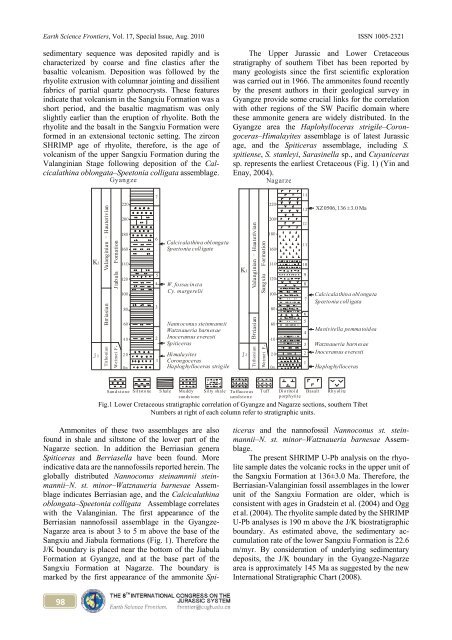in Jurassic and Cretaceous Stratigraphy
in Jurassic and Cretaceous Stratigraphy
in Jurassic and Cretaceous Stratigraphy
Create successful ePaper yourself
Turn your PDF publications into a flip-book with our unique Google optimized e-Paper software.
Earth Science Frontiers, Vol. 17, Special Issue, Aug. 2010 ISSN 1005-2321<br />
sedimentary sequence was deposited rapidly <strong>and</strong> is<br />
characterized by coarse <strong>and</strong> f<strong>in</strong>e clastics after the<br />
basaltic volcanism. Deposition was followed by the<br />
rhyolite extrusion with columnar jo<strong>in</strong>t<strong>in</strong>g <strong>and</strong> dissilient<br />
fabrics of partial quartz phenocrysts. These features<br />
<strong>in</strong>dicate that volcanism <strong>in</strong> the Sangxiu Formation was a<br />
short period, <strong>and</strong> the basaltic magmatism was only<br />
slightly earlier than the eruption of rhyolite. Both the<br />
rhyolite <strong>and</strong> the basalt <strong>in</strong> the Sangxiu Formation were<br />
formed <strong>in</strong> an extensional tectonic sett<strong>in</strong>g. The zircon<br />
SHRIMP age of rhyolite, therefore, is the age of<br />
volcanism of the upper Sangxiu Formation dur<strong>in</strong>g the<br />
Valang<strong>in</strong>ian Stage follow<strong>in</strong>g deposition of the Calcicalath<strong>in</strong>a<br />
oblongata–Speetonia colligata assemblage.<br />
Gyangze<br />
98<br />
K1<br />
J 3<br />
Hauterivian<br />
-<br />
Valang<strong>in</strong>ian<br />
Brriasian<br />
Tithonian<br />
Jiabula Fomation<br />
Weimei F.<br />
220<br />
200<br />
180<br />
160<br />
140<br />
120<br />
100<br />
80<br />
60<br />
40<br />
20<br />
0m<br />
S<strong>and</strong>stone<br />
7<br />
6<br />
5<br />
4<br />
3<br />
2<br />
1<br />
Calcicalath<strong>in</strong>a oblongata<br />
Speetonia colligate<br />
W. fossac<strong>in</strong>cta<br />
Cy. margerelii<br />
Nannoconus ste<strong>in</strong>mannii<br />
Watznaueria barnesae<br />
Inoceramus everesti<br />
Spiticeras<br />
Hi malayites<br />
Corongoceras<br />
Haploghylloceras strigile<br />
Siltstone S hale Mu ddy Silty sh ale<br />
T uff Dioritoid<br />
san dsto ne<br />
p orp hyrite<br />
The Upper <strong>Jurassic</strong> <strong>and</strong> Lower <strong>Cretaceous</strong><br />
stratigraphy of southern Tibet has been reported by<br />
many geologists s<strong>in</strong>ce the first scientific exploration<br />
was carried out <strong>in</strong> 1966. The ammonites found recently<br />
by the present authors <strong>in</strong> their geological survey <strong>in</strong><br />
Gyangze provide some crucial l<strong>in</strong>ks for the correlation<br />
with other regions of the SW Pacific doma<strong>in</strong> where<br />
these ammonite genera are widely distributed. In the<br />
Gyangze area the Haplohylloceras strigile–Coron-<br />
goceras–Himalayites assemblage is of latest <strong>Jurassic</strong><br />
age, <strong>and</strong> the Spiticeras assemblage, <strong>in</strong>clud<strong>in</strong>g S.<br />
spitiense, S. stanleyi, Saras<strong>in</strong>ella sp., <strong>and</strong> Cuyaniceras<br />
sp. represents the earliest <strong>Cretaceous</strong> (Fig. 1) (Y<strong>in</strong> <strong>and</strong><br />
Enay, 2004).<br />
Nagarze<br />
K1<br />
J 3<br />
Brriasian Valang<strong>in</strong>ian - Hauterivian<br />
Tith on ian<br />
Tuffaceous<br />
s<strong>and</strong>stone<br />
Sangxiu Formation<br />
.<br />
Weimei F<br />
220<br />
200<br />
180<br />
160<br />
140<br />
120<br />
100<br />
80<br />
60<br />
40<br />
20<br />
0m<br />
14<br />
13<br />
12<br />
11<br />
10<br />
9<br />
8<br />
7<br />
6<br />
5<br />
4<br />
3<br />
2<br />
1<br />
XZ0506, 136 ±3.0 Ma<br />
Calcicalath<strong>in</strong>a oblongata<br />
Speetonia colligata<br />
Manivitella pemmatoidea<br />
Watznaueria barnesae<br />
Inoceramus everesti<br />
Haploghylloceras<br />
Basalt Rh yolite<br />
Fig.1 Lower <strong>Cretaceous</strong> stratigraphic correlation of Gyangze <strong>and</strong> Nagarze sections, southern Tibet<br />
Numbers at right of each column refer to stratigraphic units.<br />
Ammonites of these two assemblages are also<br />
found <strong>in</strong> shale <strong>and</strong> siltstone of the lower part of the<br />
Nagarze section. In addition the Berriasian genera<br />
Spiticeras <strong>and</strong> Berriasella have been found. More<br />
<strong>in</strong>dicative data are the nannofossils reported here<strong>in</strong>. The<br />
globally distributed Nannoconus ste<strong>in</strong>amnnii ste<strong>in</strong>-<br />
mannii–N. st. m<strong>in</strong>or–Watznaueria barnesae Assem-<br />
blage <strong>in</strong>dicates Berriasian age, <strong>and</strong> the Calcicalath<strong>in</strong>a<br />
oblongata–Speetonia colligata Assemblage correlates<br />
with the Valang<strong>in</strong>ian. The first appearance of the<br />
Berriasian nannofossil assemblage <strong>in</strong> the Gyangze-<br />
Nagarze area is about 3 to 5 m above the base of the<br />
Sangxiu <strong>and</strong> Jiabula formations (Fig. 1). Therefore the<br />
J/K boundary is placed near the bottom of the Jiabula<br />
Formation at Gyangze, <strong>and</strong> at the base part of the<br />
Sangxiu Formation at Nagarze. The boundary is<br />
marked by the first appearance of the ammonite Spi-<br />
ticeras <strong>and</strong> the nannofossil Nannoconus st. ste<strong>in</strong>-<br />
mannii–N. st. m<strong>in</strong>or–Watznaueria barnesae Assem-<br />
blage.<br />
The present SHRIMP U-Pb analysis on the rhyo-<br />
lite sample dates the volcanic rocks <strong>in</strong> the upper unit of<br />
the Sangxiu Formation at 136±3.0 Ma. Therefore, the<br />
Berriasian-Valang<strong>in</strong>ian fossil assemblages <strong>in</strong> the lower<br />
unit of the Sangxiu Formation are older, which is<br />
consistent with ages <strong>in</strong> Gradste<strong>in</strong> et al. (2004) <strong>and</strong> Ogg<br />
et al. (2004). The rhyolite sample dated by the SHRIMP<br />
U-Pb analyses is 190 m above the J/K biostratigraphic<br />
boundary. As estimated above, the sedimentary ac-<br />
cumulation rate of the lower Sangxiu Formation is 22.6<br />
m/myr. By consideration of underly<strong>in</strong>g sedimentary<br />
deposits, the J/K boundary <strong>in</strong> the Gyangze-Nagarze<br />
area is approximately 145 Ma as suggested by the new<br />
International Stratigraphic Chart (2008).

















